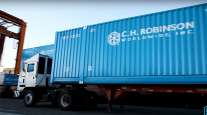Senior Reporter
West, East Coast Ports See Big Container Drop-Off in January

[Stay on top of transportation news: Get TTNews in your inbox.]
As negotiations resume between the International Longshore and Warehouse Union and management’s Pacific Maritime Association, concern is mounting at the West Coast ports that the slow pace of contract talks is damaging import and export shipping business.
And the January container volume numbers show a significant year-over-year drop at the ports of Los Angeles and Long Beach, Calif.
The Port of Los Angeles reported a 16.1% year-over-year decline as the facility processed 726,013 20-foot-equivalent unit (TEU) containers compared with 865,595 the same month the prior year. That marked the sixth straight month of declines. The port is operating at about 80% capacity.
Port executive director Gene Seroka said he expects February’s container volumes to also be very soft, in part because of the annual Lunar New Year in Asia when factories close for a two-week celebration.
LIVE NOW: Watch the Feb. 23, 2023 Regular Meeting of the Los Angeles Board of Harbor Commissioners.https://t.co/EaC0xbDQHV pic.twitter.com/tpLJHtg24O — Port of Los Angeles (@PortofLA) February 23, 2023
But he says the uncertainty over the labor contract is the key factor for the decline as the ILWU and PMA tried to calm the waters with a statement on Feb. 23.
The two sides “continue to negotiate and remain hopeful of reaching a deal soon. The parties have reached a tentative agreement on certain key issues, including health benefits, and remain committed to resolving remaining issues as expeditiously as possible. Talks are continuing on an ongoing basis until an agreement is reached.”
“I think we still have a ways to go,” Seroka said. “There are five key issues that both sides are negotiating. We’ll probably need a couple of more months, but the exporters and importers have voiced their power as well. They’ve shipped cargo to the East Coast and Gulf Coast ports because of concerns over labor unrest.”
The Port of Long Beach saw a 28.3% year-over-year decrease in container volume to 573,772 TEUs compared with 800,943 a year ago.
The Port of Oakland saw a 15.6% decline as the facility processed 163,058 containers compared with 193,205 in the same month in 2022. In the annual State of the Port address Feb. 15, executive director Danny Wan said he and his team are focusing on modernizing the facility.
The Port of Savannah’s loaded container exports grew 21 percent in January. The nation’s busiest port for U.S. goods handled 110,305 twenty-foot equivalent container units of exports, an increase of 19,419 TEUs.https://t.co/R7Bd9i241c#GAPorts #GrowingBig #GlobalGateway pic.twitter.com/5i6uDHevLX — Georgia Ports (@GaPorts) February 15, 2023
“We need to build for the next generation,” said Wan. “It is a future port that not only moves more cargo, carries more passengers and attracts more visitors, but that growth will be achieved with zero-emission technology.”
The Northwest Seaport Alliance that operates facilities in Seattle and Tacoma, Wash., reported a 27.7% year-over-year decline as the complexes moved 213,095 TEUs compared with 272,291 a year ago.
Later this year officials said they expect an increase in container volume, the port said in a statement. “Starting mid-March, the Ocean Alliance’s Pearl River Express Service will begin calling the Seattle Harbor at Terminal 18. The service calls between China and the U.S. West Coast and will feature 15,000 TEU vessels. With a Seattle last-port-of-call, the service will focus on exports, bringing additional capacity for exporters in the region.”
Port Houston along the Gulf of Mexico saw a 1% year-over-year decline, after more than a year of consecutive increases. The port processed 319,990 TEUs compared to 323,427 a year ago.
“As we continue to see growth and investment in the region in both manufacturing and import distribution, we are committed to providing terminal capacity for growing demand to ensure fluidity and best-in-class service to our customers,” said Roger Guenther, executive director of the port.

Host Mike Freeze speaks with Online Transport's Randy Obermeyer about diagnostics. Hear the program above and at RoadSigns.TTNews.com.
On the East Coast, Georgia’s Port of Savannah reported its slowest January since 2020, processing 421,714 containers compared with 476,713 in 2022. Port officials said weather played a role in the decline as six vessels slated to call Savannah in late January were delayed.
But officials believe as it continues its infrastructure improvements, the port is well poised for future growth.
“Our board’s commitment to constant infrastructure improvement, even during down times, means our customers have a ready partner in growth when they need to expand their Georgia operations,” Port Board Chairman Joel Wooten said.
The Port of Virginia notched a 9.1% increase, processing 288,380 TEUs in January compared with 262,020 in 2022.
Port executive director Stephen Edwards said the speed at which trucks can get in and out of the port is a major factor for the increase.
Want more news? Listen to today's daily briefing above or go here for more info
“We are maintaining our operational efficiency. Motor carriers are moving through the gates in 40 minutes or less,” he said.
The South Carolina Ports Authority reported a 4.6% year-over-year decline in January to 215,238 TEUs from 226,515 in the same month a year ago.
The Port Authority of New York/New Jersey reports its TEU total later than the other ports, and in December the giant East Coast complex reported a 20.5% year-over-year decline, processing 613,011 containers, compared with 770,753 in 2021.




